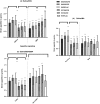Caralluma fimbriata extract activity involves the 5-HT2c receptor in PWS Snord116 deletion mouse model
- PMID: 30353709
- PMCID: PMC6305914
- DOI: 10.1002/brb3.1102
Caralluma fimbriata extract activity involves the 5-HT2c receptor in PWS Snord116 deletion mouse model
Abstract
Introduction: In Prader-Willi syndrome (PWS), nonprotein coding small nucleolar (sno) RNAs are involved in the paternally deleted region of chromosome 15q11.2-q13, which is believed to cause the hyperphagic phenotype of PWS. Central to this is SnoRNA116. The supplement Caralluma fimbriata extract (CFE) has been shown to decrease appetite behavior in some individuals with PWS. We therefore investigated the mechanism underpinning the effect of CFE on food intake in the Snord116del mouse. Experiments utilized appetite stimulants which included a 5-hydroxytryptamine (5-HT) 2c receptor antagonist (SB242084), as the 5-HT2cR is implicated in central signaling of satiety.
Methods: After 9-week chronic CFE treatment (33 mg or 100 mg kg-1 day-1 ) or placebo, the 14-week-old Snord116del (SNO) and wild-type mice (n = 72) were rotated through intraperitoneal injections of (a) isotonic saline; (b) 400 mg/kg of 2-deoxyglucose (2DG) (glucose deprivation); (c) 100 mglkg beta-mercaptoacetate (MA), fatty acid signaling; and (d) SB242084 (a selective 5HT2cR antagonist), with 5 days between reagents. Assessments of food intake were from baseline to 4 hr, followed by immunohistochemistry of neural activity utilizing c-Fos, neuropeptide Y, and alpha-melanocyte-stimulating hormone within hypothalamic appetite pathways.
Results: Caralluma fimbriata extract administration decreased food intake more strongly in the SNO100CFE group with significantly stimulated food intake demonstrated during coadministration with SB242084. Though stimulatory deprivation was expected to stimulate food intake, 2DG and MA resulted in lower intake in the snord116del mice compared to the WT animals (p = <0.001). Immunohistochemical mapping of hypothalamic neural activity was consistent with the behavioral studies.
Conclusions: This study identifies a role for the 5-HT2cR in CFE-induced appetite suppression and significant stimulatory feeding disruptions in the snord116del mouse model.
Keywords: 5-HT2c receptor; Caralluma Fimbriata extract; Prader-Willi syndrome (PWS); appetite signaling; cactus supplement; snord116 deletion.
© 2018 The Authors. Brain and Behavior published by Wiley Periodicals, Inc.
Figures



Similar articles
-
Single-Case Study of Appetite Control in Prader-Willi Syndrome, Over 12-Years by the Indian Extract Caralluma fimbriata.Genes (Basel). 2019 Jun 12;10(6):447. doi: 10.3390/genes10060447. Genes (Basel). 2019. PMID: 31212875 Free PMC article.
-
The use of Caralluma fimbriata as an appetite suppressant and weight loss supplement: a systematic review and meta-analysis of clinical trials.BMC Complement Med Ther. 2021 Nov 10;21(1):279. doi: 10.1186/s12906-021-03450-8. BMC Complement Med Ther. 2021. PMID: 34758791 Free PMC article.
-
Abnormal response to the anorexic effect of GHS-R inhibitors and exenatide in male Snord116 deletion mouse model for Prader-Willi syndrome.Endocrinology. 2014 Jul;155(7):2355-62. doi: 10.1210/en.2013-2083. Epub 2014 Apr 15. Endocrinology. 2014. PMID: 24735326
-
Prader-Willi syndrome imprinting centre deletion mice have impaired baseline and 5-HT2CR-mediated response inhibition.Hum Mol Genet. 2019 Sep 15;28(18):3013-3023. doi: 10.1093/hmg/ddz100. Hum Mol Genet. 2019. PMID: 31087031 Free PMC article.
-
Cognitive deficits in the Snord116 deletion mouse model for Prader-Willi syndrome.Neurobiol Learn Mem. 2019 Nov;165:106874. doi: 10.1016/j.nlm.2018.05.011. Epub 2018 May 23. Neurobiol Learn Mem. 2019. PMID: 29800646 Free PMC article. Review.
Cited by
-
What can we learn from PWS and SNORD116 genes about the pathophysiology of addictive disorders?Mol Psychiatry. 2021 Jan;26(1):51-59. doi: 10.1038/s41380-020-00917-x. Epub 2020 Oct 20. Mol Psychiatry. 2021. PMID: 33082508 Review.
-
Single-Case Study of Appetite Control in Prader-Willi Syndrome, Over 12-Years by the Indian Extract Caralluma fimbriata.Genes (Basel). 2019 Jun 12;10(6):447. doi: 10.3390/genes10060447. Genes (Basel). 2019. PMID: 31212875 Free PMC article.
-
The effect of an orally-dosed Caralluma Fimbriata extract on appetite control and body composition in overweight adults.Sci Rep. 2021 Mar 24;11(1):6791. doi: 10.1038/s41598-021-86108-2. Sci Rep. 2021. PMID: 33762661 Free PMC article. Clinical Trial.
-
The use of Caralluma fimbriata as an appetite suppressant and weight loss supplement: a systematic review and meta-analysis of clinical trials.BMC Complement Med Ther. 2021 Nov 10;21(1):279. doi: 10.1186/s12906-021-03450-8. BMC Complement Med Ther. 2021. PMID: 34758791 Free PMC article.
-
Preclinical Testing in Translational Animal Models of Prader-Willi Syndrome: Overview and Gap Analysis.Mol Ther Methods Clin Dev. 2019 Mar 14;13:344-358. doi: 10.1016/j.omtm.2019.03.001. eCollection 2019 Jun 14. Mol Ther Methods Clin Dev. 2019. PMID: 30989085 Free PMC article. Review.
References
-
- Ambadasu, B. , Dange, S. , & Wali, R. (2013). Effect of Caralluma fimbriata extract on appetite, body weight & lipid profile in cafeteria diet–induced obesity in rats. International Journal of Pharmacy and Pharmaceutical Sciences, 5, 536–539.
-
- Astell, K. J. , Mathai, M. L. , McAinch, A. J. , Stathis, C. G. , & Su, X. Q. (2013). A pilot study investigating the effect of Caralluma fimbriata extract on the risk factors of metabolic syndrome in overweight and obese subjects: A randomised controlled clinical trial. Complementary Therapies in Medicine, 21, 180–189. 10.1016/j.ctim.2013.01.004 - DOI - PubMed
-
- Canton, H. , Emeson, R. B. , Barker, E. L. , Backstrom, J. R. , Lu, J. T. , Chang, M. S. , & Sanders‐Bush, E. (1996). Identification, molecular cloning, and distribution of a short variant of the 5‐hydroxytryptamine2C receptor produced by alternative splicing. Molecular Pharmacology, 50, 799–807. - PubMed
Publication types
MeSH terms
Substances
LinkOut - more resources
Full Text Sources
Medical

